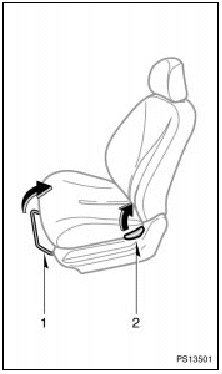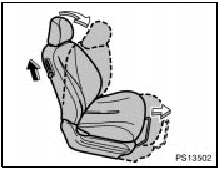 Toyota Yaris: Front seats
Toyota Yaris: Front seats
—Front seat precautions
Driver seat
CAUTION.
The SRS driver airbag deploys with considerable force, and can cause death or serious injury especially if the driver is very close to the airbag.
The National Highway Traffic Safety Administration (“NHTSA”) advises: Since the risk zone for driver airbag is the first 50—75 mm (2—3 in.) of inflation, placing yourself 250 mm (10 in.) from your driver airbag provides you with a clear margin of safety.
This distance is measured from the center of the steering wheel to your breastbone. If you sit less than 250 mm (10 in.) away now, you can change your driving position in several ways: Move your seat to the rear as far as you can while still reaching the pedals comfortably.
Slightly recline the back of the seat. Although vehicle designs vary, many drivers can achieve the 250 mm (10 in.) distance, even with the driver seat all the way forward, simply by reclining the back of the seat somewhat. If reclining the back of your seat makes it hard to see the road, raise yourself by using a firm, non-slippery cushion, or raise the seat if your vehicle has that feature.
If your steering wheel is adjustable, tilt it downward. This points the airbag toward your chest instead of your head and neck.
The seat should be adjusted as recommended by NHTSA above, while still maintaining control of the foot pedals, steering wheel, and your view of the instrument panel controls.
Front passenger seat
CAUTION.
The SRS front passenger airbag also deploys with considerable force, and can cause death or serious injury especially if the front passenger is very close to the airbag. The front passenger seat should be as far from the airbag as possible with the seatback adjusted, so the front passenger sits upright.
Front seats (with SRS side airbags)
CAUTION.
The SRS side airbags are installed in the driver and front passenger seats.
Observe the following precautions.
Do not lean against the front door when the vehicle is in use, since the side airbag inflates with considerable speed and force. Otherwise, you may be killed or seriously injured.
Do not use seat accessories which cover the area where the side airbags inflate. Such accessories may prevent the side airbags from activating correctly, causing death or serious injury.
Do not modify or replace the seats or upholstery of the seats with side airbags. Such change may prevent the side airbag system from activating correctly, disable the system or cause the side airbag system to inflate accidentally, resulting in death or serious injury.
—Seat adjustment precautions
CAUTION.
Do not adjust the seat while the vehicle is moving as the seat may unexpectedly move and cause the driver to lose control of the vehicle.
Be careful that the seat does not hit a passenger or luggage.
After adjusting the seat position, release the lever and try sliding the seat forward and backward to make sure it is locked in position.
After adjusting the seatback, push your body back against the seat to make sure the seat is locked in position.
Do not put objects under the seats.
Otherwise, the objects may interfere with the seat-lock mechanism or unexpectedly push up the seat position adjusting lever and the seat may suddenly move, causing the driver to lose control of the vehicle.
While adjusting the seat, do not put your hands under the seat or near the moving parts. Otherwise, your hands or fingers may be caught and injured.
—Adjusting front seats

1. SEAT POSITION ADJUSTING LEVER.
Hold the center of the lever and pull it up. Then slide the seat to the desired position with slight body pressure and release the lever.
2. SEATBACK ANGLE ADJUSTING LEVER.
Lean forward and pull the lever up.
Then lean back to the desired angle and release the lever.
CAUTION.
Avoid reclining the seatback any more than needed. The seat belts provide maximum protection in a frontal or rear collision when the driver and the front passenger are sitting up straight and well back in the seats. If you are reclined, the lap belt may slide past your hips and apply restraint forces directly to the abdomen or your neck may contact the shoulder belt. In the event of a frontal collision, the more the seat is reclined, the greater the risk of death or personal injury.
—Moving passenger’s seat for rear seat entry (3-door models only)

For easy access to the rear seat:
1. Lift up the seatback lock release lever.
The seat will slide forward.
2. Move the seat to the front-most position.
After rear passengers are in, lift up the seatback and return the seat until it locks.
CAUTION.
After putting back the seat, try pushing the seat forward and rearward to make sure it is secured in place.
 Seats
Seats
While the vehicle is being driven, all vehicle occupants should have the seatback
upright, sit well back in the seat and properly wear the seat belts provided.
CAUTION.
Do not drive the vehicle un ...
 Rear seats
Rear seats
—Rear seat precautions
CAUTION.
Do not adjust the seat while the vehicle is moving.
Be careful that the seat does not hit a passenger or luggage.
Be careful not to get your hands or feet pinch ...
See also:
Tire inflation pressure
■ Tire inflation pressure
The recommended cold tire inflation pressure and tire size are displayed on the
tire and loading information label. (→P. 351)
■ Inspection and adjustm ...
Floor side rail front panel (ASSY): Sedan
REPLACEMENT
With the body lower back panel removed.
REMOVAL
INSTALLATION
Temporarily install the new parts and measure each part of the new parts in accordance
with the body dimension diagra ...
Emissions Inspection and Maintenance (I/M) programs
Some states have vehicle emission inspection programs which include OBD (On-Board
Diagnostics) checks.
The OBD system monitors the operation of the emission control system. When the
OBD system de ...
